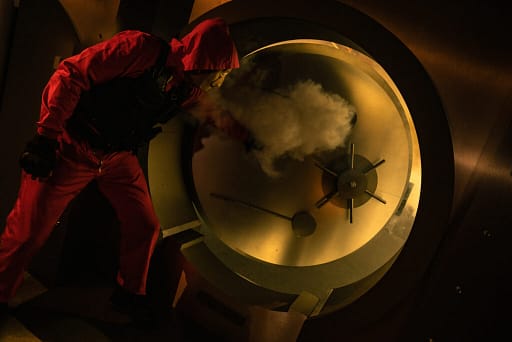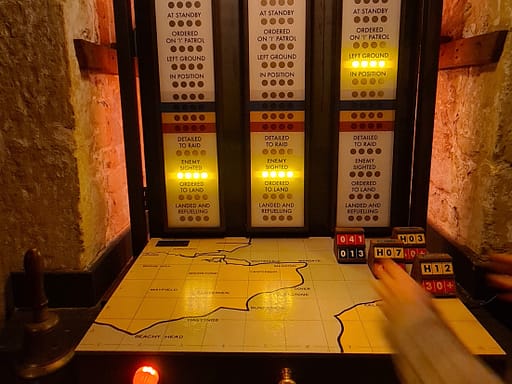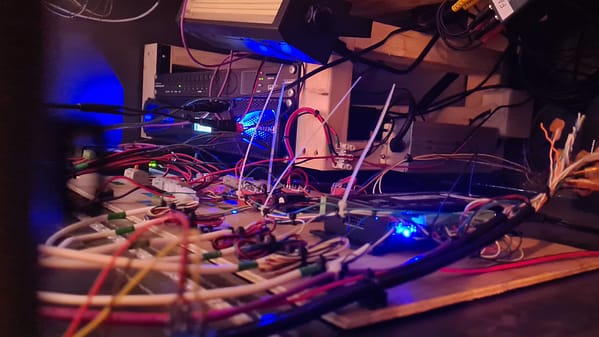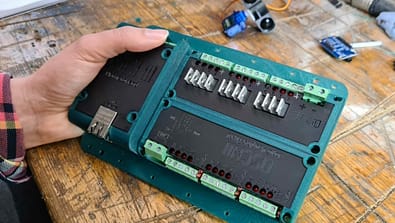Escape games can be so much more than a series of brain tickling puzzles. They can be woven into theatrical adventures or museum settings. At their best, they include multidimensional challenges that are part of a complex and gripping adventure.

OSCHII helps us integrate escape games into larger theatrical, immersive and museum experiences by creating a network that connects all kinds of things: from lights and sounds to sensors, buttons and game controllers. As participants move through their adventure, their actions, movements and reactions can trigger various components of the games and experience.
In our work designing games for Money Heist: The Experience, we incorporated game elements into a theatrical adventure to create an immersive experience that interfaces with actors and participants in real time as they search for a secret vault of gold in Christie’s auction house. Interactive buttons allow performers and stage managers to queue aspects of the story and enhance the journey.
In the Magna Carta Murders escape room at Westgate Towers, we transformed an existing museum environment into an immersive game-space by turning life-sized statues into game pieces. As players identify statues in the correct order they illuminate, eventually releasing a secret code.

For multidisciplinary games with many components, OSCHII allows us to orchestrate all elements of the game play from a central place. In The Comms Room escape experience, we devised a multifaceted game that included vintage telephones that gave clues players can use to place a prop on the correct place on a map. Once all the pieces are in the correct place, a drawer pops open, giving the key to the next game. OSCHII’s networking capabilities allowed us to control every aspect of the adventure from one place.

OSCHII was born out of frustration and passion. For several years we produced theatrical and immersive interactive games with patched together technologies that were time consuming, complex and didn’t always live up to our creative vision. We decided it was time to turn our hard-won lessons into a new, easy to use and integrated platform. OSCHII would let us create and help others create.
We began building Escape Rooms a few years ago using off the shelf tech, mostly designed for ‘fright’ experiences such as haunted houses.
In many ways they were great--designed to be installed by people with limited experience and knowledge of immersive technology. We love the idea of making this kind of tech accessible to a wide range of creators.
But the more we worked with them, the more time consuming, complicated and expensive using this so-called simple to use, “DIY” technology became. As the games developed, the circuitry got more complicated and, unfortunately, messier. We spent long hours up to our eyebrows in wires and circuit boards hacking everything together. In the end, it just wasn't powerful enough, it didn't quite do what we wanted it to do, and the many hundreds of additional hours spent making circuits that allowed us to do what we wanted to do was, well, getting silly and unaffordable.
It’s fair to say that our escape rooms are fairly technologically complex.
The game technology that we use needs to network with all sorts of other things: atmospheric lighting and audio, billowing smoke, and props such as vintage telephones or swinging lights.
Because we specialise in immersive theatre, we know how to use the whole environment to affect emotion and enhance the journey of the participants. The game technology that we use needs to network with all sorts of other things: atmospheric lighting and audio, billowing smoke, and props such as vintage telephones or swinging lights. As participants move through this adventure, we also need to be able to lock and unlock game elements as one challenge ends and another begins.
We experimented with slightly different technology for our second escape room, bringing it closer to the comfort of our work in immersive theatre and allowing us to inject more drama into the experience.

Sound, light, and atmospherics were all carefully scripted and programmed into a complete timeline. In our theatrical productions, we use software that automates many functions within a show to create a slick, fully immersive experience that injects suspense and can leave people with goosebumps.
Yet we still faced the same difficulties integrating this software with the off-the-shelf games hardware. We really needed a technology that was built with all of this in mind.
Outside of work with escape rooms, we encountered similar problems.
We’ve made several large-scale interactive games for festivals, such as a challenge in which around 50 participants joining hands trigger a light show that demonstrates how working together can initiate change. Another game is the terrifying immersive adventure in which the participant becomes a fish caught by a super trawler.
Each time we create these experiences we spend more time working on the technology than focusing on improving the actual game experience itself. We wanted to make more time for creativity and artistry.
Escape Rooms, immersive theatre, interactive off-line gaming and sensory artworks all have many things in common - they are highly engaging, interactive, immersive, playable and fun activities that are part of a wider family of experiences. Their creation is also often sadly hindered by a lack of technical knowledge. Whilst creating OSCHII, we wanted to use our experiences in these creative industries to make a technology that can be shared with others. We wanted to reduce the steepness of that learning curve and the headaches that came with hacked together webs of technology. We wanted to be able to create, and allow others to create.
It was time to make life easier for us and cheaper for our clients. It was time to help other creators focus on artistry instead of technology. It was time for a new, better, DIY immersive technology.
Then came the pandemic. We had time! We bring you OSCHII.

We’re excited to introduce OSCHII, our homegrown technology that allows audiences to interact with artworks and their environments - which in turn are able to respond to the audience. OSCHII makes it possible for artists, designers, performers and games makers - pretty much anyone - to use technology to make their ideas truly interactive.
Let’s be honest, not all creators are also passionate about learning to code or the intricacies of computer programming. OSCHII makes the process of integrating interactive technology into artistic projects easier, faster and more affordable. Rather than spending time and energy learning complicated systems, creators can focus on doing what they love - be it designing a soundscape in real time, telling a story that inspires and responds to a person’s movement through a space, or bringing vintage technologies back to life for new purposes.
OSCHII has a wide variety of applications including escape rooms, immersive theatre, and interactive art and museum exhibitions. With a wave of the hand, a participant might set off a sudden blaze of light, play the first few notes of a symphony, decode secret war time communications or unlock the door to another realm. OSCHII can also collect signals and data from the physical and virtual world, such as the location of an artefact; the concentration of air pollutants by a school, the most appreciated tree on a marsh, or the number of times a hashtag has been used.
OSCHII is designed to make device to device and person to person communication easier. It helps simplify connectivity by eliminating the steep learning curves associated with other processors like Arduino and Raspberry Pi. Instead, it allows users to learn the basics, and then use graphics-driven computer programs to manipulate the data they are collecting or sharing. The hardware itself provides the building blocks that can be expanded on as your project evolves.
So, what is OSCHII? OSCHII believes that technology should help rather than hinder creativity. It allows a wide range of creators to make works that respond to participants in real time and helps artists and audiences to connect and create. At its core OSCHII believes everyone is an artist.